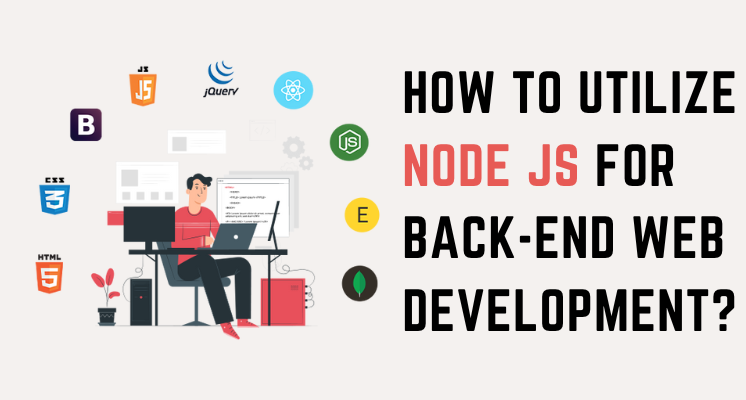How to Utilize Node Js for Back-end Web Development?

Node.js is a platform for servers that is based on the JavaScript Engine found in Google Chrome. With Node.js, you can create server-side and networking applications. You write Node.js programs in JavaScript, and they run on various operating systems such as OS X, Microsoft Windows, and Linux. Node.js also has a large library of JavaScript modules, which makes it easier to develop Node.js web applications. For individuals interested in expanding their skill set, exploring Graphic Design Courses In Chennai can offer valuable insights into creating visually appealing and engaging designs. Understanding Node.js can significantly benefit graphic designers by enabling them to integrate interactive and dynamic elements into their designs, facilitating the creation of visually stunning and innovative web applications and digital experiences. This blog will explore “How to Utilize Node Js for Back-end Web Development?”.
In Node.js, the program runs in a single process instead of creating a new thread for each request. Node.js mostly avoids blocking behavior, thanks to its standard library that provides asynchronous I/O primitives, which prevents JavaScript code from blocking. Additionally, libraries in Node.js are often designed using non-blocking methods. Node.js is currently gaining a lot of popularity. Some big companies like Netflix, Uber, PayPal, and Twitter are already using Node.js for their operations.
Is Node.js used for Front-end or Back-end?
Sometimes developers misunderstand Node.js as a back-end framework only for building servers. This is not true. Node.js can be used for both front-end and back-end development. Its event-driven, non-blocking nature makes it a popular choice for creating flexible and scalable back-ends. To learn both front-end and back-end development, join the Full Stack Developer Course In Chennai and become an expert in Full Stack.
Here are some reasons why Node.js is suitable for both back-end and front-end development:
Reusability: JavaScript, with the support of frameworks like Express.js and Meteor.js, can be used for writing both front-end and back-end code. Components can be shared between the two, facilitating code reuse.
Productivity and Developer Efficiency: Using the same language for both front-end and back-end development reduces the need for switching between different languages, enhancing developer efficiency and saving time.
Large Community: Node.js benefits from a large and active online community, making problem-solving easier. Many solutions can be found on platforms like Stack Overflow, which contributes to a more efficient development cycle.
While certain tasks may be challenging with Node.js alone, several frameworks have been developed to assist developers. Some popular Node.js frameworks include:
Nest.js: A powerful back-end framework suitable for building large-scale projects. It implements various programming principles like Typescript, Model-View-Presenter (MVP), and Object-Oriented Programming (OOP). For individuals interested in advancing their skill set, exploring an Artificial Intelligence Course In Chennai can offer valuable insights into understanding the applications and potential of AI in various industries. Learning Node.js can benefit individuals pursuing AI by providing them with a robust and efficient back-end framework to develop and deploy AI-powered applications, leveraging its scalability and powerful features to create sophisticated and cutting-edge solutions in the field of artificial intelligence.
Express.js: A lightweight framework with a comprehensive set of HTTP helpers. It is commonly used for building APIs, mobile apps, and web applications, particularly when a rapid development process is preferred.
Socket.io: A user-friendly framework primarily focused on enabling real-time bidirectional communication. It supports features such as reconnection, binary support, and multiplexing.
Meteor.js: Enables real-time functionality, dynamic imports, and front-end-back-end connectivity, with added API protection.
Koa.js: Uses asynchronous methods to simplify error handling and improve application performance.
Loopback.io: Enables quick API creation by providing various features and supporting ad-hoc queries, storage services, and a range of REST services and databases.
What is the Purpose of Node.js?
Node.js is popular mainly for its speed. It enables quick data processing, client-server interaction, and overall development. This speed is made possible by Node.js’s event-driven two-way connections, facilitating communication and data exchange between the client and the server. Its unique input/output approach allows Node.js to perform exceptionally well in scalable and real-time scenarios, which are increasingly demanded by modern web servers.
Furthermore, Node.js is known for its speed and lightweight nature. Its capability to utilize JavaScript code on both the front-end and the back end offers new possibilities for development. This flexibility between the front-end and the back end makes the developer community more efficient and versatile, thereby reducing development costs. For those interested in mastering Node.js and becoming proficient in full-stack development, considering Full Stack Developer Courses in Bangalore can provide comprehensive insights into utilizing Node.js for building scalable and high-performance applications. Understanding Node.js in conjunction with full-stack development can enable developers to create seamless and efficient web applications, leveraging its asynchronous and event-driven capabilities for enhanced performance and user experience.
How is Node.js different from Web JavaScript?
JavaScript is a scripting language primarily used in web browsers. On the other hand, Node.js acts as a JavaScript interpreter or execution environment equipped with essential libraries and components. While JavaScript is a standalone programming language operating within default browser environments. It is commonly employed for tasks like data validation in web applications.
Hope you would have understood “How to Utilize Node Js for Back-end Web Development?”. Node.js incorporates various relevant libraries commonly used in general-purpose programming with JavaScript. It functions as an interpreter or environment that can interpret and execute any JavaScript program. Its key role involves facilitating non-blocking operations, such as gathering operating system-specific information like certificates or hardware data. This allows JavaScript to be utilized beyond the scope of web browsers. It enables tasks such as scripting, executing back-end services, or running on hardware. For individuals keen on expanding their skill set, exploring a comprehensive UI UX Design Course in Chennai can provide valuable insights into creating intuitive and user-friendly interfaces. Understanding Node.js can significantly benefit UI/UX designers by enabling them to incorporate dynamic and interactive elements into their designs, thus enhancing the overall user experience and usability of their products and applications.